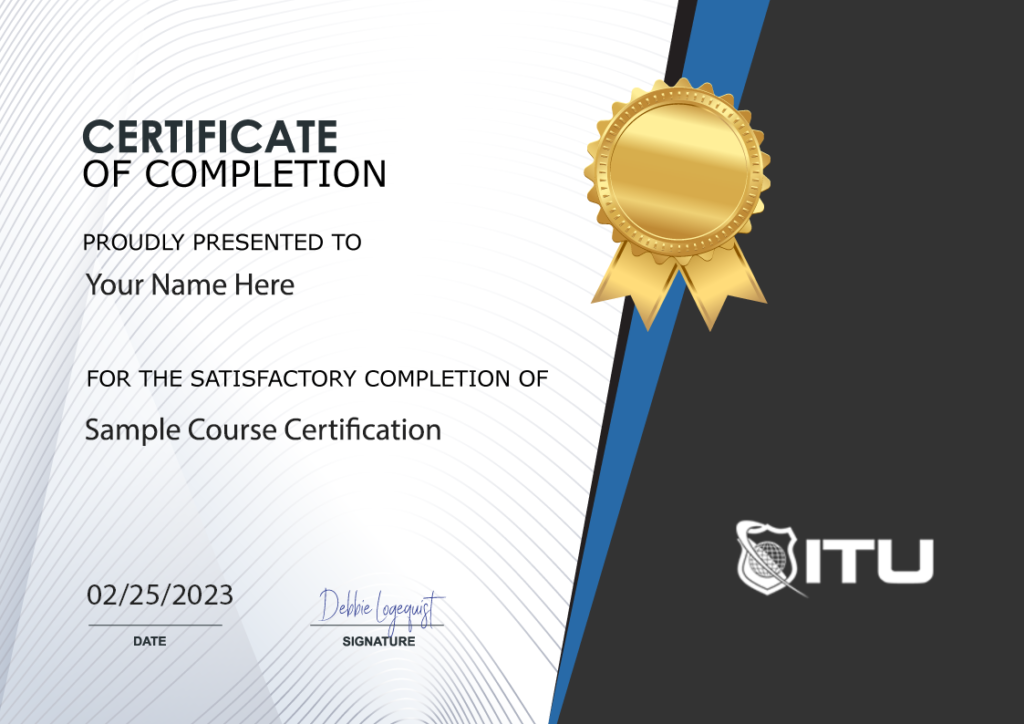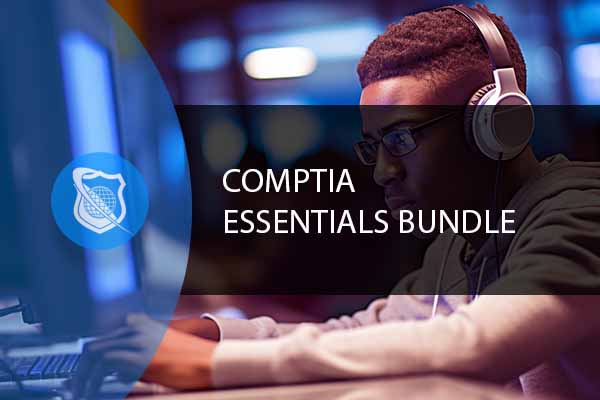Essential CompTIA Certification: A+, Network+, Security+
Are you looking to sharpen your IT skills and get certified? Look no further! This essential CompTIA certification training bundle offers A+, Network+ and Security+ certifications that are highly valued technical skills. Our IT course is loaded with over 100 hours of digital bootcamp, flashcards, games, exam questions and more.
Included In This Course



Closed Captions



Certificate of Completion
Your essential CompTIA certification training bundle includes A+, Network+, and Security+. A CompTIA certification is widely valued in IT careers and training. You will receive three courses with over 100 hours of training that includes digital video bootcamps, flashcards, games, and practice exam questions. Whether you are new to IT, or looking for instruction and study material to pass your recertification exams, this bundle contains everything you can possibly need.
This CompTIA certification bundle includes the following courses:
- CompTIA A+ 220-1101 (Core 1)
- CompTIA A+ 220-1102 (Core 2)
- CompTIA Network+ N10-008
- CompTIA Security+ (SY0-601)
With this series, you can be prepared for the following essential CompTIA certifications.
About CompTIA A+
Passing a series of exams developed by IT industry experts is the only way to receive your CompTIA A+ certification. However, this accreditation isn’t limited to just PC repair; it provides you with aptitude in handling and resolving an array of tech issues from networking and OS problems to security on mobile devices. With a wider range of information than any other certification, CompTIA A+ is the most relevant and up-to-date credential for today’s technicians. Rather than just focusing on one domain, its courses equip you with multiple skills that can be applied in countless job roles. When you master these essential CompTIA certification courses, you’ll be prepared to continue your path to more intensive training and certifications.
With CompTIA A+, IT students are equipped with the tools necessary to access valuable data regardless of the device being used To excel in this field, key skills and knowledge include:
- Setting up and adjusting end-user devices and software for optimal performance.
- Interconnect devices to maximize their potential within an organizations network.
- Take essential steps to ensure cybersecurity safety and protection.
- Proactively address frequent issues to identify and solve problems.
- Show a strong comprehension of scripting, cloud computing, and virtualization.
CompTIA A+ 1100 series is tailored to the needs of a hybrid workforce and equips IT professionals with essential knowledge and aptitudes that are required in current technology.
- CompTIA A+ is designed to keep up with the ever-changing and dynamic nature of IT jobs. Those who have achieved certification are able to quickly determine if it’s more efficient to repair something in house or send specific technologies straight away to vendors, thus saving time and money.
- CompTIA A+ provides the necessary skills to capitalize on today’s modern Software as a Service (SaaS) solutions, essential for successful virtual operations.
- The recently updated CompTIA A+ is specifically designed to focus on troubleshooting and providing solutions for software, hardware or connectivity issues remotely.
- A+ is dedicated to elevating the standard of core technology, including data management and scripting, cloud infrastructure, as well as security for IoT devices.
- A+ certifications now include the most popular operating systems, their usage scenarios, and key maintenance requirements. Therefore, technicians are better equipped to handle all kinds of operating systems efficiently.
About CompTIA Network+
CompTIA Network+ equips IT professionals with the competencies necessary to ensure a secure and resilient network, ranging from configuring and managing wired/wireless devices to grasping essential security concepts, cloud computing best practices, cutting-edge hardware technologies and virtualization techniques.
Possible job opportunities:
- Network Administrator
- System Engineer
- Network Analyst
- Computer Technician
- Help Desk Technician
- Network Support Specialist
About Security+
By passing the Security+ exam, you can prove that you possess the necessary knowledge and abilities to evaluate a business’s security posture, suggest and apply proper security systems, observe hybrid environments securely and with compliance of relevant laws & regulations as well as recognize, assess, and react to safety incidents. This IT course is recommended for IT administration with 2+ years of experience and a focus on security.
Possible job opportunities:
- Network / Cloud Engineer
- Security Engineer / Analyst
- DevOps
- Software Developer
- Security Administrator
- Systems Administrator
- IT Project Manager
Frequently Asked Questions About Essential CompTIA Certification: A+, Network+, Security+
What does the Essential CompTIA Certification training bundle include?
The Essential CompTIA Certification training bundle includes comprehensive training for three CompTIA certifications: A+, Network+, and Security+. The bundle consists of over 100 hours of training that includes digital video bootcamps, flashcards, games, and practice exam questions. The specific courses included are CompTIA A+ 220-1101 (Core 1), CompTIA A+ 220-1102 (Core 2), CompTIA Network+ N10-008, and CompTIA Security+ (SY0-601).
Who would benefit from the Essential CompTIA Certification training bundle?
This training bundle is suitable for both individuals new to IT and those looking for instruction and study material to pass their recertification exams. The CompTIA A+ certification is generally seen as an entry-level rite of passage for IT technicians, while the Network+ and Security+ certifications are suitable for professionals with some experience in networking and security respectively.
How are the courses in the Essential CompTIA Certification training bundle delivered?
The courses are delivered as on-demand content, which means you can access the training materials at any time that is convenient for you. The training materials include digital video bootcamps, flashcards, games, and practice exam questions.
What is the duration of the Essential CompTIA Certification training bundle?
The training bundle offers 101 hours of training across 60 topics, with 545 videos and 778 practice questions to aid your learning.
What are the benefits of obtaining CompTIA certifications?
CompTIA certifications are widely recognized in the IT industry and can help improve your career prospects. The A+ certification is a requirement for service technicians at Dell, Intel, and HP, and is recognized by the U.S. Department of Defense. The Network+ certification is recommended or required by Dell, HP, and Intel, and is also an accepted entry-point certification for the Apple Consultants Network. The Security+ certification, while not having any prerequisites, is recommended for individuals with at least two years of IT administration experience with a security focus.
How can I get access to the Essential CompTIA Certification training bundle?
ou can get access to this training and over 2,500 hours of on-demand content with the All Access Monthly Subscription offered by ITU Online. You can start today with 7 free days and there’s no obligation, meaning you can cancel anytime.
Proudly DisplayYour Achievement
Upon completion of your training, you’ll receive a personalized certificate of completion to help validate to others your new skills.
CompTIA Security+ SY0-701 Course Content
Module 1 - SY0-701 General Security Concepts
- 1.0 Introduction to the Course
- 1.1 Fundamental Security Concepts
- 1.2 Zero Trust
- 1.3 Deception and Disruption
- 1.3.1 ACTIVITY - Testing a Honeypot
- 1.4 Security Controls
- 1.5 Change Management and Security
- 1.6 Cryptography Basics
- 1.6.1 ACTIVITY - Examining Symmetric Encryption
- 1.7 Asymmetric Encryption
- 1.7.1 ACTIVITY - Exploring Asymmetric Encryption
- 1.8 Hashing
- 1.8.1 ACTIVITY - Verifying Integrity with Hashing
- 1.9 Digital Certificates
- 1.10 Public Key Infrastructure
- 1.11 Data and Keys
- 1.12 Crypto Implementations
- 1.13 Blockchain
- 1.14 Non-Cryptographic Data Protection
Module 2 - SY0-701 Threats, Vulnerabilities, and Mitigations
- 2.1 Threat Actors and Motivations
- 2.2 Threat Vectors
- 2.2.1 ACTIVITY - O.MG Cable Baiting
- 2.2.2 O.MG-No Cable
- 2.3 Social Engineering
- 2.4 Operating System Vulnerabilities and Attacks
- 2.5 Application Vulnerabilities and Attacks
- 2.5.1 ACTIVITY - Performing a Buffer Overflow
- 2.6 Web-based Vulnerabilities and Attacks
- 2.6.1 ACTIVITY - Abusing Unsanitized Input
- 2.6.2 ACTIVITY - Grabbing Passwords with SQL Injection
- 2.6.3 ACTIVITY - Swiping a Token with XSS
- 2.7 Other Vulnerabilities
- 2.8 Common Malicious Activity Indicators
- 2.9 Insider Threat Indicators
- 2.10 Social Engineering Indicators
- 2.10.1 ACTIVITY - Capturing Credentials through Social Engineering
- 2.11 Malware Activity Indicators
- 2.12 Operating System Attack Indicators
- 2.13 Application Attack Indicators
- 2.13.1 ACTIVITY - Recognizing Directory Traversal
- 2.14 Physical Attack Indicators
- 2.14.1 ACTIVITY - Quickly Cloning an RFID Badge
- 2.15 Network Attack Indicators
- 2.15.1 ACTIVITY - Crashing a Target with DoS
- 2.16 Cryptographic Attack Indicators
- 2.17 Password Attack Indicators
- 2.17.1 ACTIVITY - Password Cracking
- 2.18 Network Segmentation
- 2.19 Access Control
- 2.20 Enterprise Device Hardening
Module 3 - SY0-701 Security Architecture
- 3.1 Network Segmentation
- 3.1.1 ACTIVITY - Segementing a Network
- 3.2 High Availability
- 3.3 Virtualization
- 3.3.1 ACTIVITY - Deploying Docker Containers
- 3.4 Cloud
- 3.5 Serverless Computing
- 3.6 IoT
- 3.7 ICS SCADA
- 3.7.1 ACTIVITY - Operating a SCADA System
- 3.8 RTOS and Embedded Systems
- 3.9 Reducing the Attack Surface
- 3.10 Firewalls
- 3.11 IDS IPS.mp4
- 3.12 Secure Communications - Access
- 3.13 Port Security
- 3.14 SD-WAN and SASE
- 3.15 Data Classifications
- 3.16 Protecting Data Types
- 3.17 Data Considerations
- 3.18 Redundancy
- 3.19 Alternate Sites
- 3.20 Multiple Platforms
- 3.21 Business Continuity
Module 4 - SY0-701 Security Operations
- 4.1 Secure Baselines
- 4.2 Attack Surface Reduction
- 4.3 Wireless Installation
- 4.4 Wireless Security Settings
- 4.5 Mobile Solutions
- 4.5.1 ACTIVITY - Pwning a Mobile Device
- 4.6 Application Security Management
- 4.7 Asset Management
- 4.8 Vulnerability Management
- 4.9 Monitoring Activities
- 4.10 Monitoring Tools
- 4.10.1 ACTIVITY - Scanning a Network for Vulnerabilities
- 4.11 Firewall Configuration
- 4.11.1 ACTIVITY - Configuring Firewall Rules
- 4.12 Intrusion Detection Configuration
- 4.13 Web Traffic Filtering
- 4.14 Operating System Policy
- 4.14.1 ACTIVITY - Examining Windows Group Policy
- 4.15 Network Service Security
- 4.16 Data Loss Protection
- 4.16.1 ACTIVITY - Checking File Integrity
- 4.17 Network Access Control
- 4.17.1 ACTIVITY - Require Multifactor Authentication
- 4.18 Identity Management
- 4.19 Access Management
- 4.19.1 ACTIVITY - Implementing Access Control
- 4.20 Security Automation
- 4.21 Incident Response
- 4.22 Digital Forensics
Module 5 - SY0-701 Security Program Management and Oversight
- 5.1 Elements of Effective Security Governance
- 5.2 Elements of the Risk Management Process
- 5.3 Third Party Risk Assessment and Management
- 5.3.1 ACTIVITY - Analyzing the Solar Winds Supply Chain Failure
- 5.4 Effective Security Compliance
- 5.5 Audits and Assessments
- 5.5.1 ACTIVITY - Conducting OSINT
- 5.5.2 ACTIVITY - Performing Active Reconnaissance
- 5.6 Security Awareness Practices
- 5.7 Course Outro
CompTIA A+ 220-1101 (Core 1) Course Content
Module 1 - Devices, Setups, and Installs
- 1.1 Introduction to the Course, Meet the Instructor
- 1.2 Appropriate Safety Procedures
- 1.3 PC Components
- 1.4 Guidlines for PC Disassembly
- 1.5 Motherboards
- 1.6 CPU Sockets
- 1.7 PCI Bus
- 1.8 Storage Bus (SATA and IDE)
- 1.9 Discussing PC Components
- 1.10 Common Connection Interfaces
- 1.11 Wired and Wireless Connection Standards
- 1.12 Install Peripheral Devices
- 1.13 Guidlines and Discussion for Installing Peripheral Devices
Module 2 - Displays and Multimedia Devices
- 2.1 Displays and Multimedia
- 2.2 Display Device Connections and Cables
- 2.3 Discussing Display Device Installation and Configuration
- 2.4 Troubleshoot Display Devices
- 2.5 Guidelines for Troubleshooting Display Devices
- 2.6 Discussing Display Device Troubleshooting
- 2.7 Install and Configure Multimedia Devices
- 2.8 Discussing Multimedia Device Installation and Configuration
Module 3 - Supporting Multiple Drive Types
- 3.1 Supporting Multiple Drive Types and Memory
- 3.2 Memory Types
- 3.3 RAM Types
- 3.4 Memory Modules
- 3.5 DIMM and SO-DIMM Technologies
- 3.6 Parity and ECC RAM
- 3.7 Memory Compatibility Issues
- 3.8 Discussing System Memory Installation
- 3.9 Install and Configure Mass Storage Devices
- 3.10 Storage Adapters and Cables
- 3.11 Solid State Drives
- 3.12 Guidlines for Installing Mass Storage Devices
- 3.13 Discussing Mass Storage Device Installation and Configuration
- 3.14 Install and Configure Removable Storage
- 3.15 Discussing Removable Storage Device Istallation and Configuration
- 3.16 Configure RAID
- 3.17 RAID Configuration Options
- 3.18 Discussing RAID Configuration
- 3.19 Troubleshoot Storage Devices
- 3.20 Boot Failures
- 3.21 Discussing Storage Device Troubleshooting
Module 4 - Accounting for CPUs and Internal Components
- 4.1 Install Upgrade CPUs
- 4.2 Multiprocessing and Multicore Processors
- 4.3 Discussing CPU Upgrades
- 4.4 Configure and Update BIOS UEFI
- 4.5 Discussing BOIS-UEFI Configuration and Updates
- 4.6 Install Power Supplies
- 4.7 Discussing Power Supply Installation
- 4.8 Troubleshoot Internal System Components
- 4.9 POST and Boot Problems
- 4.10 Boot Troubleshooting and Log Entries
- 4.11 Motherboard Component Problems
- 4.12 Discussing System Component Troubleshooting
Module 5 - All About Network Theories
- 5.1 Wired Networks
- 5.2 Common Ethernet Network Implementations
- 5.3 Taps and Mirrors
- 5.4 Discussing Wired Networks
- 5.5 Network Hardware Devices
- 5.6 Switches
- 5.7 Power Over Ethernet
- 5.8 Discussing Network Hardware Devices
- 5.9 Wireless Networks
- 5.10 Access Points and Wireless Network Modes
- 5.11 Discussing Wireless Networks
- 5.12 Internet Connection Types
- 5.13 Wireless Internet Service Providers WISP
- 5.14 Discussing Internet Connection Types
- 5.15 Network Configuration Concepts
- 5.16 The TCIP-IP Protocol Suite
- 5.17 Internet Protocol and IP Addressing
- 5.18 Public and Private IP Addresses
- 5.19 IPv6
- 5.20 Discussing Network Configuration Concepts
- 5.21 Network Services
- 5.22 DNS
- 5.23 Dynamic and Static IP Configurations
- 5.24 DNS Records MX and A
- 5.25 Web Servers and HTTP-HTTPS
- 5.26 Discussing Network Services
Module 6 - Network Operations and Diagnostics
- 6.1 Configuring and Troubleshooting Networks
- 6.2 Network Connections in Windows
- 6.3 Install and Configure SOHO Networks
- 6.4 Configure SOHO Network Security
- 6.5 Firewalls
- 6.6 Port Fowarding and Port Triggering
- 6.7 Windows Firewall
- 6.8 Network Security and Embedded Appliances
- 6.9 Configure Remote Access
- 6.10 Discussing Remote Access Configuration
- 6.11 Troubleshoot Network Connections
- 6.12 IP Configuration Issues
- 6.13 Routing Issues
- 6.14 Discussing Network Connection Troubleshooting
Module 7 - Cloud and Virtualization Computing
- 7.1 Configure Client-Side Virtulaization
- 7.2 Hypervisors
- 7.3 Processor Support and Resource Requirements
- 7.4 Virtual Networks
- 7.5 Client-Side Virtualization
- 7.6 Cloud Computing Concepts
- 7.7 Internal and External Shared Resources
- 7.8 Cloud Service Options
- 7.9 Virtual Desktops
- 7.10 Software-Defined Networking (SDN)
- 7.11 Discussing Cloud Computing Concepts
Module 8 - Laptop Features and Troubleshooting
- 8.1 Use Laptop Features
- 8.2 Expansion Options
- 8.3 Discussing Laptop Features
- 8.4 Install and Configure Laptop Hardware
- 8.5 Discussing Laptop Hardware Installation and Configuration
- 8.6 Troubleshoot Common Laptop Issues
- 8.7 Discussing Troubleshooting Common laptop Issues
Module 9 - Syncing and Setup of Mobile Devices
- 9.1 Syncing and Setup of Mobile Devices
- 9.2 Connect and Configure Mobile Devices
- 9.3 Configure Mobile Device Network Connectivity
- 9.4 Mobile VPN Configuration
- 9.5 Email Configuration Options
- 9.6 Discussing Mobile Device Network Connectivity Configuration
- 9.7 Support Mobile Apps
- 9.8 Discussing Mobile App Support
Module 10 - All Things Printing
- 10.1 All Things Printing
- 10.2 Discussing Laser Printer Maintenance
- 10.3 Maintain Inkjet Printers
- 10.4 Discussing Inkjet Printer Maintenance
- 10.5 Maintain Impact, Thermal, and 3D Printers
- 10.6 Discussing Impact, Thermal, and 3D Printer Maintenance
- 10.7 Install and Configure Printers
- 10.8 Discussing Printer Installation and Configuration
- 10.9 Troubleshoot Print Device Issues
- 10.10 Install and Configure Imaging Devices
- 10.11 Discussing Device Installation and Configuration
Module 11 - Resources and Testing
- 11.1 Introduction to Resources and Testing
- 11.2 Resources and Testing
- 11.3 Joining a Domain with Windows 10
- 11.4 Boot Order and BIOS
- 11.5 Virtual Machine Install & Configure
- 11.6 PC Teardown
- 11.7 Exploring the Laptop
- 11.8 Install Windows 10 Demonstration
CompTIA A+ 220-1102 (Core 2) Course Content
Module 1 - Operating System Management
- 1.1 Introduction to the Course, Meet the Instructor
- 1.2 Identify Common Operating Systems
- 1.3 Microsoft Windows
- 1.4 Work and Education Features
- 1.5 Windows System Limits
- 1.6 Apple Operating Systems
- 1.7 Linux Disk and File Management
- 1.8 Discussing OS Types
- 1.9 Use Windows Features and Tools
- 1.10 Administrative Tools
- 1.11 Manage Files in Windows
- 1.12 System Hierarchies
- 1.13 File Attributes
- 1.14 Discussing Windows Features and Tools
- 1.15 Manage Disks in Windows
- 1.16 Discussing File Management in Windows
- 1.17 The Windows Disk Management Console
- 1.18 Discussing Windows Disk Management
- 1.19 Manage Devices in Windows
- 1.20 Device Manager
- 1.21 Discussing Windows Device Manager
Module 2 - Configuring and installing the OS
- 2.1 Configuring and Installing the OS
- 2.2 Installation Boot Methods
- 2.3 Disk Formatting and Partitioning
- 2.4 Networking Considerations
- 2.5 Post Installation Tasks
- 2.6 OS Installation Types
- 2.7 Unattended Installations
- 2.8 Maintain OSs
- 2.9 OS Updates
- 2.10 Anti-Malware Updates
- 2.11 Scheduled Backups
- 2.12 Task Schedulers part 1
- 2.13 Task Schedulers part 2
- 2.14 Install Windows 10 Demonstration
- 2.15 Discussing OS Maintenance
Module 3 - Tools to Troubleshoot and Maintain the OS
- 3.1 Install and Manage Windows Applications
- 3.2 Windows OS Tools
- 3.3 Application and Print Services
- 3.4 Task Manager
- 3.5 Manage Windows Performance
- 3.6 Windows Performance Management Tools
- 3.7 Troubleshoot Windows
- 3.8 Event Viewer
- 3.9 The System Configuration Utility
- 3.10 Troubleshooting Tips Boot Process
- 3.11 Troubleshooting Tips for Windows System Issues
- 3.12 Blue Screens and Spontaneous Shutdowns
- 3.13 Troubleshooting Tips for File and Memory Corruption
- 3.14 Safe Boot
- 3.15 System Repair Disc
- 3.16 System Restore
- 3.17 Guidelines for Troubleshooting Windows Issues
Module 4 - Network Management Tools
- 4.1 Network Management Tools
- 4.2 Network Connectivity
- 4.3 IP Addressing and Connection Types
- 4.4 Proxy Settings
- 4.5 Windows Client Configuration
- 4.6 Location Services
- 4.7 Firewalls
- 4.8 Network Troubleshooting
- 4.9 Remote Desktop Tools
- 4.10 Desktop Management and Remote Monitoring Tools
- 4.11 Disscussion Topics
Module 5 - Sharing Resources and Wrights Management
- 5.1 Sharing Resources and Wrights Management
- 5.2 User Group Accounts
- 5.3 Local Secutity Policy
- 5.4 SSO and Credential Manager
- 5.5 Workgroups and Homegroups
- 5.6 Network and Sharing Center
- 5.7 Network Share Configuration
- 5.8 NTSF File and Folder Permissions
- 5.9 Configure Active Directory Accounts and Policies
- 5.10 Domain Membership and Group Policy Objects
- 5.11 Basic AD Functions
- 5.12 Account Locks and Password Resets
Module 6 - Threats and Security Measures
- 6.1 Threats and Security Measures
- 6.2 Logical Security Concepts
- 6.3 Encryption
- 6.4 PKI and Certificates
- 6.5 Execution Control
- 6.6 NAC
- 6.7 Discussing Logical Decurity Concepts
- 6.8 Threats and Vulnerablilities
- 6.9 Types of Password Attacks
- 6.10 Discussing Threats and Vulnerabilities
- 6.11 Physical Security Controls
- 6.12 Discussing Physical Security Measures
Module 7 - Policies to Protect Data
- 7.1 Policies to Protect Data
- 7.2 Implement Security Best Practices
- 7.3 Guidlines for Implementing Security Best Practices
- 7.4 Discussing Security Best Practices Implementation
- 7.5 Implement Data Protection Policies
- 7.6 ACLs and Directory Permissions
- 7.7 Full Disk Encryption
- 7.8 Guildlines for Implementing Data Protection Policies
- 7.9 Discussing Data Protection Policies
- 7.10 Protect Data During Incident Response
- 7.11 Discussing Data Protection During Incident Response
Module 8 - Prevent Malware and Security Threats
- 8.1 Prevent Malware and Security Threats
- 8.2 Detect, Remove, and Prevent Malware
- 8.3 Trojan Horses and Spyware
- 8.4 Sources of Malware Infection
- 8.5 Best Practices for Malware Removal
- 8.6 Discussing Detecting, Removing, and Preventing Malware Infections
- 8.7 Troubleshoot Common Workstation Security Issues
- 8.8 Discussing Troubleshoot Common Workstation Security Issues
Module 9 - Supporting and Troubleshooting Mobile Devices
- 9.1 Supporting and Troubleshooting Mobile Devices
- 9.2 Secure Mobile Devices
- 9.3 IOT Internet of Things
- 9.4 Discussing Mobile Device Security
- 9.5 Troubleshoot Mobile Device Issues
- 9.6 Mobile Device Security Troubleshooting
- 9.7 Discussing Troubleshooting Mobile Devices
Module 10 - Implementing Operational Procedures
- 10.1 Implementing Operational Procedures
- 10.2 Environmental Impacts and Controls
- 10.3 Discussing Environmental Impact and Controls
- 10.4 Create and Maintain Documentation
- 10.5 Discussing Documentation Creation and Maintenance
- 10.6 Use Basic Change Management Best Practices
- 10.7 Discussing Change Management Best Practices
- 10.8 Implement Disaster Prevention and Recovery Methods
- 10.9 Discussing Implement Disaster Prevention and Recovery Methods
- 10.10 Basic Scripting Concepts
- 10.11 Discussing Scripting
- 10.12 Professionalism and Communication
- 10.13 Discussing Professionalism and Communication Skills
Module 11 - Resources and Testing
- 11.1 Introduction to Resources and Testing
- 11.2 Resources and Testing
- 11.3 Joining a Domain with Windows 10
- 11.4 Boot Order and BIOS
- 11.5 Virtual Machine Install & Configure
- 11.6 PC Teardown
- 11.7 Exploring the Laptop
- 11.8 Install Windows 10 Demonstration
CompTIA Network+ N10-008 Course Content
Module 0 - Course introduction
- 0.1 Instructor Intro
- 0.2 Course Overview
Module 1 - Networking Fundamentals
- 1.1 Intro to Networking
- 1.1.1 Activity: Creating a Network
- 1.2 Common Terminology
- 1.2.1 Activity: Examining Ports and Sockets
- 1.3 OSI Model
- 1.4 DoD Model
- 1.4.1 Activity: Examining Network Layers
- 1.5 TCP, UDP, IP
- 1.5.1 Activity: Examining TCP
- 1.5.2 Activity: Examining UDP
- 1.5.3 Activity: Examining IP
- 1.6 ICMP, IGMP, ARP
- 1.6.1 Activity: Examining ICMP
- 1.6.2 Activity: Examining ARP
- 1.6.3 Activity: Examining IGMP
- 1.7 Network Topologies
- 1.8 Network Types
- 1.9 Part 1: Network Characteristics
- 1.9 Part 2: Network Characteristics
- 1.10 Module 1 outro
Module 2 - Cables and Connectors
- 2.1 Ethernet Standards
- 2.2 Copper Cable Types
- 2.3 Fiber Optic Cable Types
- 2.4 Connector Types
- 2.4.1 Activity: Selecting the Right Cable
- 2.5 Media Converters and Transceivers
- 2.6 Cable Management
- 2.7 Module 2 Outro
Module 3 - Internet Protocol (IP)
- 3.1 IPv4 Basics
- 3.2 IP Packet and Interface Types
- 3.2.1 Activity: Configuring Client IP Settings
- 3.3 Binary Numbering System
- 3.4 Classful and Classless Addressing
- 3.5 Understanding CIDR Notation
- 3.6 IPv4 Subnetting Method
- 3.7 Verifying with Binary
- 3.8 Finding Subnet IDs
- 3.8.1 Activity: Subnetting a Class C Network
- 3.9 The Delta in Action
- 3.9.1 Activity: Subnetting With the Delta
- 3.10 Subnetting Based on Hosts
- 3.11 Subnetting in Other Octets
- 3.12 Supernetting
- 3.12.1 Activity: Supernetting
- 3.13 IPv6
- 3.14 IPv4 - IPv6 Transition Mechanisms
- 3.15 Module 3 Outro
Module 4 - Layer 7 Protocols
- 4.1 Remote Control Protocols
- 4.2 File Sharing Protocols
- 4.3 Web Protcols
- 4.4 Email Protocols
- 4.5 Database Protocols
- 4.6 Voice Protocols
- 4.7 Security Protocols
- 4.8 Management Protocols
- 4.9 Module 4 Outro
Module 5 - Network Services
- 5.1 DHCP
- 5.1.1 Activity: Configuring DHCP
- 5.1.2 Activity: Configuring a DHCP Relay Agent
- 5.2 DNS
- 5.2.1 Activity: Configuring DNS - Part 1
- 5.2.2 Activity: Configuring DNS - Part 2
- 5.3 NTP
- 5.4 Corporate and Datacenter Network Architecture
- 5.5 Cloud Concepts and Connectivity Options
- 5.6 Module 5 Outro
Module 6 - Networking Devices
- 6.1 Introductory Concepts
- 6.2 Repeaters and Hubs
- 6.2.1 Activity: Connecting Devices with a Hub
- 6.3 Bridges and Switches
- 6.3.1 Activity: Connecting Devices with a Switch
- 6.4 Routers and Multilayer Switches
- 6.5 Security Devices
- 6.6 Modems
- 6.7 Module 6 Outro
Module 7 - Networked Devices
- 7.1 IP Devices
- 7.2 IoT
- 7.2.1 Activity - Programming IoT Devices
- 7.3 ICS/SCADA
- 7.4 Module 7 Outro
Module 8 - Routing and Bandwidth Management
- 8.1 Routing Basics
- 8.1.1 Activity: Configuring Static Routes
- 8.2 Packet Delivery on the Same Network
- 8.3 IP Routing Across a Single Router
- 8.4 IP Routing Across Multiple Hops
- 8.4.1 Activity: Static Routes - CHALLENGE
- 8.5 Route Selection
- 8.6 RIP
- 8.6.1 Activity: Configuring RIP - CHALLENGE
- 8.7 OSPF
- 8.8 EIGRP
- 8.9 BGP
- 8.10 NAT/PAT
- 8.11 Bandwidth Management (with Module 8 Outro)
Module 9 - Ethernet Switching
- 9.1 Ethernet Basics
- 9.2 Switching Overview
- 9.2.1 Activity: Examining a MAC Table
- 9.3 VLANs
- 9.3.1 Activity: Creating VLANs
- 9.4 VLAN Trunking
- 9.4.1 Activity: Configuring VLAN Trunking
- 9.5 VLAN Routing
- 9.5.1 Activity: Configuring VLAN Routing
- 9.6 Contention Management
- 9.7 Switchport Configuration (with Module 9 Outro)
Module 10 - Wireless Technologies
- 10.1 Wireless Overview
- 10.2 Radio Basics
- 10.3 Modulation
- 10.4 Wi-Fi Standards
- 10.5 Antennas
- 10.6 Wi-Fi Service Sets
- 10.7 Wi-Fi Security
- 10.8 Cellular
Module 11 Network Performance
- 11.1 Monitoring Performance
- 11.2 Common Metrics
- 11.2.1 Activity: Examining Interface Statistics
- 11.3 SNMP
- 11.4 Netflow
- 11.5 Network Security Monitoring (with Module 11 Outro)
Module 12 High Availability and Disaster Recovery
- 12.1 HA and DR Concepts
- 12.2 High Availability Mechanisms
- 12.3 Disaster Recovery Mechanisms
- 12.4 Facility and Infrastructure Support (with Module 12 Outro)
Module 13 Organizational Documents
- 13.1 Plans and Procedures
- 13.2 Security Policies
- 13.3 Loss Prevention
- 13.4 Common Agreements
- 13.5 Common Documentation
- 13.6 Structured Cabling - MDF and IDF
- 13.7 Horizontal and Vertical Cabling
- 13.7.1 Activity - Implementing Cable Management
- 13.8 Labeling
- 13.9 Surveys and Assessments (with Module 13 Outro)
Module 14 Network Security
- 14.1 Common Security Concepts
- 14.2 Common Attack Types
- 14.3 Spoofing-based Attacks
- 14.4 Hijacking and MITM
- 14.5 Social Engineering
- 14.6 Network Segmentation
- 14.7 Private VLANs
- 14.8 Single Organization Authentication
- 14.9 Extending Authentication
- 14.10 Authorization
- 14.11 Network Device Hardening
- 14.12 Wireless Security
- 14.13 Remote Access Security
- 14.14 IoT Security
- 14.15 Physical Security (with Module 14 Outro)
Module 15 Network Troubleshooting
- 15.1 Troubleshooting Methodology
- 15.2 Physical Connectivity Issues
- 15.3 Hardware Testing Tools
- 15.3.1 Activity - Testing an Ethernet Cable
- 15.3.2 Activity - Crimping on an RJ-45 Connector
- 15.3.3 Activity - Punching Down Twisted Pair
- 15.3.4 Activity - Using a Telephone Toner
- 15.4 Understanding Electricity
- 15.4.1 Activity - Checking Cable Continuity
- 15.4.2 Activity - Testing DC Voltage
- 15.4.3 Activity - Testing AC Voltage
- 15.5 Twisted Pair Pinout Problems
- 15.6 Twisted Pair Termination Problems
- 15.7 Repairing Damaged Twisted Pair Cable
- 15.8 Fiber Optic Connectivity Issues
- 15.8.1 Activity - Testing a Fiber Optic Cable
- 15.9 Common Port Problems
- 15.9.1 Working with Ports and Their Devices
- 15.10 Common Software Testing Tools
- 15.10.1 Activity - Scanning for Open Ports
- 15.11 Common Command Line Utilities
- 15.12 Troubleshooting Basic IP Networking Issues
- 15.13 Common Switching Issues
- 15.14 Switching Test Tools and Techniques
- 15.15 Common IP Routing Issues
- 15.16 Wi-Fi Access Point Issues
- 15.17 Wirelss Interference
- 15.17.1 Activity - Using a Spectrum Analyzer
- 15.18 Wireless Antenna Issues
- 15.18.1 Activity - Configuring a Wi-Fi Router
- 15.19 WAP Placement Strategies
- 15.20 Infrastructure Service Issues (DHCP)
- 15.21 Infrastructure Service Issues (DNS)
- 15.22 Infrastructure Service Issues (NTP)
- 15.23 Fireall / ACL Issues
- 15.24 VPN Issues
- 15.25 Additional Network Security Troubleshooting and Tips
- 15.26 Advanced Networking Issues
- 15.27 Troubleshooting Server Services (with Module 15 Outro)
- CompTIA Network+ N10-008 Course Outro
CompTIA Security+ (SY0-601) Course Content
Module 1: Information Security Roles Security Control and Framework Types
- Introduction and Overview
- Compare and Contrast Information Security Roles
- Compare and Contrast Security Control and Framework Types
- Module Summary
Module 2: Explain Threat Actor Types, Attack Vectors, and Intelligence Sources
- Explain Threat Actor Types and Attack Vectors
- Explain Threat Intelligence Sources
- Module Summary
Module 3: Organizational Security, Network Reconnaissance, General Vulnerability Types, Penetration Testing
- Assess Organizational Security with Network Reconnaissance Tools
- Packet Capture and Replay Demo
- Explain Security Concerns with General Vulnerability Types
- Summarize Vulnerability Scanning Techniques
- Explain Penetration Testing Concepts
- Module Summary
Module 4: Social Engineering, Indicators of Malware Attacks
- Compare and Contrast Social Engineering Techniques
- Analyze Indicators of Malware-based Attacks
- Fork Bomb Malware Demo
- Module Summary
Module 5: Cryptography
- Compare and Contrast Cryptographic Ciphers
- Summarize Cryptographic Modes of Operation
- Summarize Cryptographic Use Cases and Weaknesses
- Summarize Other Cryptographic Technologies
- Module Summary
Module 6: Certificates and PKI
- Implement Certificates and Certificate Authorities
- Implement PKI Management
- Implementing a PKI Demo
- Module Summary
Module 7: Authentication
- Summarize Authentication Design Concepts
- Implement Knowledge-based Authentication
- Password Cracker Demo
- Implement Authentication Technologies
- Summarize Biometrics Authentication Concepts
- Module Summary
Module 8: Identity and Accounts, Authorization, Personnel Polices
- Implement Identity and Account Types
- Implement Account Policies
- Account Types and Polices Demo
- Implement Authorization Solutions
- Explain the Importance of Personnel Policies
- Module Summary
Module 9: Network Design and Hardware (Part 1)
- Implement Secure Network Designs
- Implement Secure Switching and Routing
- Various Types of Network Attacks Demo
- Implement Secure Wireless Infrastructure
- Implement Load Balancers
- Module Summary
Module 10: Network Hardware (Part 2)
- Implement Firewalls and Proxy Servers
- Implement Network Security Monitoring
- Summarize the Use of SIEM
- Module Summary
Module 11: Network Protocols
- Implement Secure Network Operations Protocols
- Implement Secure Application Protocols
- Implement Secure Remote Access Protocols
- Module Summary
Module 12: Endpoint Security
- Implement Secure Firmware
- Implement Endpoint Security
- Endpoint Protection Demo
- Explain Embedded System Security Implications
- Module Summary
Module 13: Mobile Devices
- Implement Mobile Device Management
- Implement Secure Mobile Device Connections
- Module Summary
Module 14: Indicators of Attacks, Intro to Secure Coding, Scripting, Deployment and Automation
- Analyze Indicators of Application Attack
- Analyze Indicators of Web Application Attacks
- Summarize Secure Coding Practices
- Implement Secure Script Environments
- Summarize Deployment and Automation Concepts
- Module Summary
Module 15: Secure Coding, Scripting, Deployment, Cloud and Virtualization
- Summarize Secure Cloud and Virtualization Services
- Apply Cloud Security Solutions
- Summarize Infrastructure as Code Concepts
- Module Summary
Module 16: Privacy and Data Protection
- Explain Privacy and Data Sensitivity Concepts
- Explain Privacy and Data Protection Controls
- Module Summary
Module 17: Incident Response
- Summarize Incident Response Procedures
- Utilize Appropriate Data Sources for Incident Response
- Apply Mitigation Controls
- Module Summary
Module 18: Forensics
- Explain Key Aspects of Digital Forensics Documentation
- Explain Key Aspects of Digital Forensics Evidence Acquisition
- Module Summary
Module 19: Risk Management and Business Impact Analysis
- Explain Risk Management Processes and Concepts
- Explain Business Impact Analysis Concepts
- Module Summary
Module 20: Redundancy and Backup Strategies
- Implement Redundancy Strategies
- Implement Backup Strategies
- Implement Cybersecurity Resiliency Strategies
- Module Summary
Module 21: Physical Security
- Explain the Importance of Physical Site Controls
- Explain the Importance of Physical Host Security Controls
- Module Summary
Module 22: Afterword
- Conclusion and General Exam Tips
| 5 star | 82 | 82% |
| 4 star | 17 | 17% |
| 3 star | 1 | 1% |
| 2 star | 0% | |
| 1 star | 0% |
Sorry, no reviews match your current selections
Your Training Instructors
Chrys Thorsen is an education and technology expert who specializes in enterprise-level IT infrastructure consulting and certified training-of-trainers. In her career, she has garnered over 50 IT Certifications including CISSP, CISA, CEHv12, PenTest+, CompTIA CNVP, Cisco CCSI/CCNP, Microsoft Cloud and on-premises technologies, VMware vSphere, and many more. She has also authored 40 published certification textbooks, and over 35 full-length IT certification video courses.
When not working in the United States, Chrys spends her time abroad capacity-building IT literacy in developing nations in Sub-Saharan Africa. Her client list has included: the US Federal Government, the Republic of Zambia Ministry of Health, Cavendish University Zambia, Accenture, JP Morgan Chase, the US Centers for Disease Control and Prevention, the Elizabeth Glaser Pediatric AIDS Foundation (EGPAF), Hughes Aircraft, Microsoft, and many more.
Chrys lives by, and is fond of repeating, her professional creed:
“The only true measure of success for any project or training is results on the ground. Everything else is just noise.” “I teach what I deploy; I deploy what I teach.”
Anton Santucci is a seasoned IT instructor with over 20 years of experience in the field. He is currently serving as an ITU instructor for the A+ Certification Course and teaching both online and in-person computer training at Hillsborough Community College (HCC) in Florida. Anton holds an Associate's Degree in Information Systems Management and is skilled in delivering complex IT information to students in a way that is easy to understand and enjoy.
He started his career as a Microsoft Certified Trainer (MCT) and has since gained expertise in CompTIA certifications such as A+, Net+, and Security+. He also holds the CEH (Certified Ethical Hacker) certification. With five years as a Network Administrator for a career college in Florida and global experience as a corporate trainer, Anton brings a wealth of knowledge and experience to his classes.
With a belief that training can be both informative and entertaining, Anton uses humor, mnemonic devices, and questions to engage his students and ensure they retain the skills they need to succeed in the workplace. In his personal life, Anton is a passionate traveler and a fan of the Giants. He looks forward to helping you achieve your certification goals while getting to know you along the way.

Subscribe To All-Access
Lock In $16.99 / Month Forever
Access this course and over 2,900 hours of focused IT training. Start your first month for only $1.00. Then lock in only $16.99 / month for life.
- Get Every Course
- Free Updates / New Content Added
- 2,900+ Hours of IT Training
- Price Lock Guarantee
- Games / Flashcards
- 22,000+ Practice Questions
- AI Study Buddy
- Certificates of Completion
$49.99 $16.99 Monthly
$59.00






good
Smooth delivery and easy access to LMS. Good to see that the LMS offers progress tracking. Would be great if badges were offered on completion of courses to share via Credly to future employers.